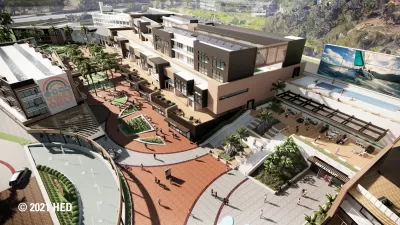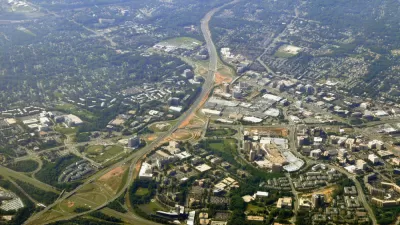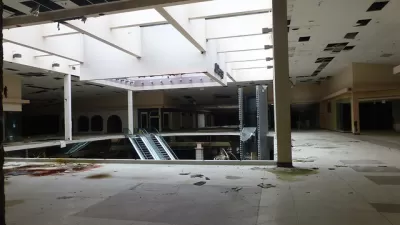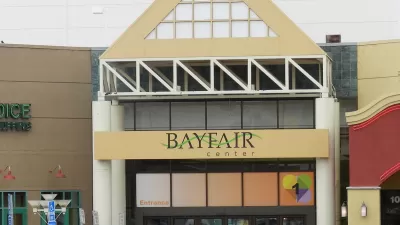Catalytic developments initiate economic and cultural improvements.

Even before the pandemic, converting retail centers to include new uses was a growing trend. Retail was already challenged by the emergence of online retailers, and according to the U.S. Census Bureau, brick-and-mortar retailers lost over 15 percent of their revenue to e-commerce in the first quarter of 2023 alone. This number is growing with no signs of stopping.
What first made retail centers successful was their original planning. In a regional urban/suburban model, retail centers were planned approximately 16 to 20 miles apart as regional destinations designed to serve local communities by providing goods and services. In turn, retail centers benefited municipalities through job creation and sales tax generation. They have always been an engine for economics and culture, but as the dynamics of consumerism have changed, so too should the retail center.
By repurposing existing retail centers into mixed-use developments, often called ‘lifestyle centers,’ city and regional planners can address these changing consumer dynamics head-on while still satisfying local and regional needs.
The multi-use appeal of a lifestyle center
A mixed-use development has the potential to transform an area into a regional destination by creating a vibrant and dynamic environment that attracts people from near and far. Such a development combines different types of land uses including residential, commercial, retail, entertainment, healthcare, commercial, and recreational, into a cohesive and interconnected space offering a multitude of amenities and experiences. With proper planning, these mixed uses offer opportunities to create a modern nexus that supports regional development and evolution. Since retail centers had their own gravity for years, adding new uses as part of a conversion to a lifestyle center reinvigorates the concept of the location as a destination and supplements it with a new local population within the residential component of the development.
A well-designed lifestyle center development can offer unique and diverse attractions that cater to a wide range of interests. By providing a comprehensive array of options, particularly experiences that cannot be replicated online such as high-end shopping boutiques, gourmet restaurants, art galleries, performance venues, recreational facilities, and public spaces for community gatherings, the development becomes a one-stop destination for individuals seeking a variety of experiences. The big box anchor tenants of many retail centers have become expendable due to e-commerce and consolidation. Now, these spaces are an opportunity for redevelopment, as their large floorplates and locations at the far ends of the retail development offer flexibility when converting to housing, entertainment, or commercial spaces.
Combining a mix of these uses into a cohesive and engaging environment, particularly with the right marketing, such developments can attract a variety of visitors from far and wide, contributing to the economic growth and vitality of the region. By showcasing the unique offerings and experiences available, the development can position itself as a must-visit regional destination.
Transforming empty retail into an activated destination
Across the country, tired retail centers are being adapted into vibrant mixed-use lifestyle centers. These mixed-use developments can cultivate a sense of place and identity, becoming a distinct and recognizable landmark within the region.
Unique architectural features that pay homage to the history, culture, and context of the region, public art installations, thoughtfully designed arrival experiences, and the incorporation of regional landscapes can create a visually appealing environment that captures the imagination of visitors. By fostering a strong sense of place, the development establishes an emotional connection with the community and draws people in to explore and experience its offerings. Including a range of free outdoor amenities like play space, hangout space, activity space, and space for traveling exhibitions lends a sense of vibrancy and energy.
Additionally, a successful mixed-use development often incorporates elements of sustainability and green spaces, enhancing its appeal as a regional destination and encouraging tenants, community members, and visitors to engage with the space. In four-season climates, this may not mean entirely open-air connections, but atriums that bring in natural daylight or strategic, seasonally activated green space, or interior green space that can provide outdoor connection in all climates. Incorporating parks, gardens, and green infrastructure not only promotes a healthier environment, but also provides opportunities for recreation and relaxation. People are attracted to places that prioritize sustainability and well-being, making a mixed-use development with such features more appealing as a regional destination.
With the largest U.S. metro areas willing to pay 35 percent more for walkable real estate, lifestyle centers are not only extremely desirable, but also a way to counteract sprawl. Retail centers were originally designed as a function of car culture: in 20 minutes, a person could get access to the goods they needed. While retail centers themselves were designed to be walkable environments, they are placed in seas of pavement or set back from the street, distancing themselves from connections to mass transit. Now, that sea of parking is a blank canvas for development to break down the scale of the building into an even more pedestrian-centric environment. Converting the main structure of an existing retail center into a multi-function environment and building new structures to break up the parking lot can improve the pedestrian experience of the property and create more tangible connections to mass transit while still offering parking to visitors and residents.
As part of the conversion from a retail center, there is an opportunity to add the right kind of uses and residential options that help reduce traffic and bring people closer to jobs, goods, and services. When doing so, it is important to plan for a mix of ages, uses, and incomes. Bringing affordable, workforce, moderate-income, and market-rate housing closer to job opportunities can significantly improve the potential for wealth retention by simply reducing the transit costs for all.
All these forces together create a blend of extended foot traffic, primary and secondary uses, and increased engagement. These properties are also highly sought after, regenerative for the region, and adaptable to the changing economic and cultural dynamics of their local environment. Walkable urban and suburban developments make residents feel happier, more connected to their community, and promote health and wellness. Converting outdated retail developments into mixed-use lifestyle centers will strengthen communities and create adaptive and flexible destinations that draw locals and visitors to the region.
Kurt Volkman, AIA, LEED AP BD+C is an Associate Principal, Housing & Mixed-Use with HED.

Maui's Vacation Rental Debate Turns Ugly
Verbal attacks, misinformation campaigns and fistfights plague a high-stakes debate to convert thousands of vacation rentals into long-term housing.

Planetizen Federal Action Tracker
A weekly monitor of how Trump’s orders and actions are impacting planners and planning in America.

Chicago’s Ghost Rails
Just beneath the surface of the modern city lie the remnants of its expansive early 20th-century streetcar system.

Bend, Oregon Zoning Reforms Prioritize Small-Scale Housing
The city altered its zoning code to allow multi-family housing and eliminated parking mandates citywide.

Amtrak Cutting Jobs, Funding to High-Speed Rail
The agency plans to cut 10 percent of its workforce and has confirmed it will not fund new high-speed rail projects.

LA Denies Basic Services to Unhoused Residents
The city has repeatedly failed to respond to requests for trash pickup at encampment sites, and eliminated a program that provided mobile showers and toilets.
Urban Design for Planners 1: Software Tools
This six-course series explores essential urban design concepts using open source software and equips planners with the tools they need to participate fully in the urban design process.
Planning for Universal Design
Learn the tools for implementing Universal Design in planning regulations.
planning NEXT
Appalachian Highlands Housing Partners
Mpact (founded as Rail~Volution)
City of Camden Redevelopment Agency
City of Astoria
City of Portland
City of Laramie





























